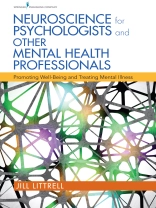This book presents the latest neuroscience and physiological explanations behind the major diagnostic categories of mental illness—including schizophrenia, depression, anxiety, and addiction—and explains the physiological bases that underlie traditional pharmaceutical treatment interventions. Crucially, it integrates current information about brain function with new research on immunology, offering a research-based rationale for viewing the mind and the body as an integrated system. The new information on the physiological bases for behavior explains how lifestyle interventions related to diet, exercise, and interpersonal relationships can have dramatic therapeutic effects on mental health.
Of particular note in this book is cutting-edge information on fast-spiking GABA interneurons and the role of NMDA receptors in psychosis, the role of inflammatory processes in mood disorders, and gut microbiota’s influence on inflammation. Beyond the physiology undergirding distress, the book also explores the physiological bases for health and resilience. Students and mental health professionals in social work, counseling, and psychology will learn how the same mechanisms available for overcoming mental anguish can be utilized for achieving life satisfaction.
KEY FEATURES:
- Discusses attention deficit hyperactivity disorder, depression, pediatric bipolar disorder, issues for children in the child welfare system, and advocacy efforts
- Presents the latest information on the efficacy and side effects of antidepressants, antipsychotics, anxiolytics, mood stabilizers, and stimulants
- Explains the mechanisms through which diet and exercise can influence mood disorders and psychosis
- Prepares mental health professionals to provide services in primary care settings in the role of the behavioral health professional
Cuprins
Contents
Preface
1. Ways of Thinking About Behavioral Syndromes
The Current Paradigm and How We Got There
History of the Diagnostic and Statistical Manuals of the American Psychiatric Association
Major Depression and Anxiety Used to Be Neurosis
The DSM-IV Continues the Tradition of Medicalizing More of Us
Controversy Over the DSM-5
The Limitations of Current Diagnostic Categories
Abandonment of the DSM-5
Extensive Nature of the Mind–Body Connection
Are Diagnoses Needed?
What Should Be the Criteria for Disorder?
Has Labeling Ordinary Behavior as Mental Illness Resulted in Better Outcomes?
The Approach in This Book
2. Physiology
Section 1: Genes and Epigenetics
The Two-Step Process of Making a Protein
How the Cell Decides Whether to Make a Protein
Epigenetics
Telomeres
Section 2: Neurons and Neurotransmitters
The Life Cycle of a Neurotransmitter
How Are the Functions of Neurotransmitters Investigated?
Specific Neurotransmitters
Section 3: The Immune System
Two Major Divisions: Innate and Adaptive Immunity
The Glial Cells
Section 4: Circuits
Appetitive Signaling
Creating Learned Helplessness
Regulation of Impulses, Motor Activity, and Emotions
Putting It All Together: BAS and BIS
Section 5: Emotions
Emotions in General
Autonomic Nervous System
Hormonal Activity
Specific Emotions
Section 6: The Human Brain Is Social
Exercises to Rehearse the Vocabulary Used in Subsequent Chapters
3. Psychopharmacology
Pharmacokinetics and Pharmacodynamics
Ways to Ingest Drugs
Ways in Which Drugs Are Eliminated From the Body
Drug Dependence
General Concepts
Major Classes of Psychotropic Drugs
Stimulants
Antipsychotics
Antidepressants
Sedative-Hypnotic Agents
Mood Stabilizers
Major Classes of Drugs of Abuse
Marijuana
Opioids
Nicotine
Alcohol
Marketing of Drugs in the United States
Concerns About Threats to Health
Concerns Over Cost
Where Does the Pharmaceutical Industry Spend Its Money?
Mechanisms for Controlling Medical Practice
Psychiatric Medications
The Role of Behavioral Health Clinicians With Regard to Pharmaceuticals
Obligations in Assuming Responsibilities for Monitoring Side Effects
Clinicians Functioning Independently
Informed-Consent Duties of Clinicians in Clear Mental Health Professional Roles
What Can Nonmedical Clinicians Say About Medications?
Websites for Information Regarding Drugs
4. Depression
The Syndrome of Depressive Behaviors
Prevalence Over Time and Cultures
Findings in Those With Major Depression
Brain Imaging and EEG Findings
Hormonal Findings
Thinking Styles
Emotional Control or Regulation
Brain-Derived Neurotrophic Factor
Theories
Learned Helplessness
Inflammation
Heritability
Drug Treatment
Efficacy
Withdrawal
Side Effects
Pregnancy
Changing Recommendations
Ketamine
Novel Drugs
Electrical Stimulation Treatment
Transcranial Magnetic Stimulation
Deep Brain Stimulation
Activities to Increase Regulatory Capacity
Cognitive Behavioral Therapy
Ways to Target Inflammation
Increasing HRV (Vagal Tone)
Direct Anti-Inflammatories
Diet
Obtaining Adequate Sleep
Exercise
Meditation
Social Engagement
Summary
Useful Websites and Information on Food
5. Anxiety
The Physiology of Anxiety
Basic Physiology of Fear
Differentiating Anxiety From Fear
Fear Memories
How Does Extinction Happen?
Possibility of Reconsolidation
Teaching Active Coping
Types of Anxiety Disorders
Generalized Anxiety Disorder
Obsessive-Compulsive Disorder
Posttraumatic Stress Disorder
Treatments
Talk Therapies
Medications for Anxiety
Other Nondrug Treatments
Ways in Which to Talk About and Deal With Past Traumatic Events
Making Decisions About How to Proceed
6. Psychotic Disorders
Physiology of Psychosis
Fast-Spiking, GABA-Producing Interneurons
Problems With the NMDA Receptor
Inflammatory Factors and Free Radicals
Limitations in Current Diagnostic Practices
Current Treatments
Side Effects With Current Treatments
Questions Raised by Long-Term Follow-Up Studies
Better Targets for Treatment
Dilemma for Society and Clinicians
7. Bipolar Disorders
History of the Concept
Why Was Bipolar II Added?
Bipolar I
Does Depression Always Occur in Those With Mania?
Bipolar II
Nonclinical College Student Samples of Bipolar II
Summary
Treatment
Must Pharmacological Treatment Be Initiated to Prevent Kindling?
The Pharmacological Treatments: Lithium, Anticonvulsants, and Atypical Antipsychotics
Efficacy of Pharmacological Treatment
Current Outcomes for Those With Bipolar II
Alternative to Drugs
Regular Routines
Omega-3s
N-Acetylcysteine
Where Have We Been and Where Are We Going?
8. Addictions
Neuroscience of Addiction
The Process of Becoming Addicted: Drug Sensitization
It Is Not About Pleasure
The Brain Is Being Changed
When Are Addicts More Vulnerable to Relapse?
Understanding Addiction
Do Addicts Use Because They Are in Pain?
Substance Abusers Are a Heterogeneous Population
Genetic Predisposition
How to Approach Clients
Is Breaking Down Denial Relevant?
New Approaches: Transtheoretical Models of Change and Motivational Interviewing
What Level of Drug Consumption Should Be Changed?
The Wisdom of Initial Sobriety
Initial Engagement
Assessing Detox Requirements
Assessing Level of Care
Goals of Treatment
Relapse Prevention
Developing Self-Regulation
Dealing With Abstinence Violation Syndrome
Pharmaceutical Treatments
Efficacy of Treatment
Reflections on U.S. Drug Policy
9. Children
Rise in Medicating Children
Pediatric Bipolar Disorder
The Push to Medicate
Side Effects of the Drugs
The Status of the Diagnosis
Major Depression
Efficacy of Antidepressants
Attention Deficit Hyperactivity Disorder
Genetics and Neurobiology
Stimulant Treatment Efficacy
Alternatives
Foster Care
Posttraumatic Stress Disorder
General Alternatives for Children
10. New Opportunities and How to Proceed
Mental Illness in the United States Is an Epidemic
Case Against Diagnoses That Create Harm
Lessons From the Resilience Literature
The Goal of Flourishing
What to Do to Increase Positive Mood
Primacy of Social Support
Humor
Music
Making Blessings Salient
Meditation and Yoga
Envisioning Positive Future Selves
Being Able to Forgive
Increasing the Probability of Taking Action
Integrating Behavioral Health Into Primary Care
Screening
Larger Social Change
Appendix: Screening Instruments
Alcohol Use Disorders Identification Test
CAGE Questionnaire
The Satisfaction With Life Scale
The Center for Epidemiologic Studies Depression Scale
Index
Despre autor
Jill Littrell, Ph D, LCSW, is Associate Professor, Georgia State University School of Social Work.












